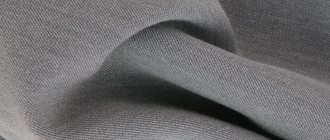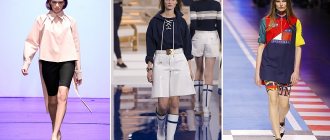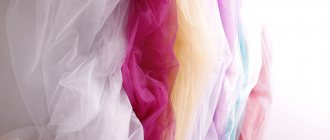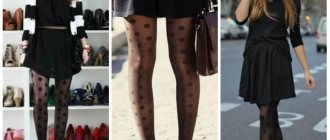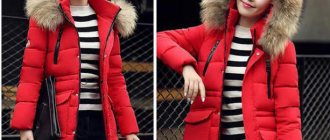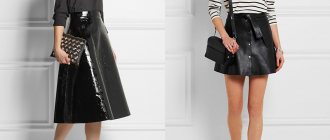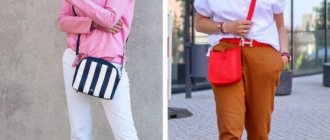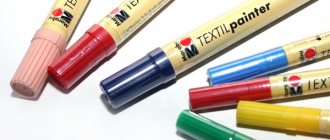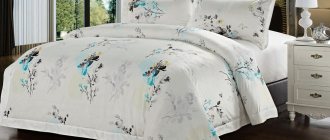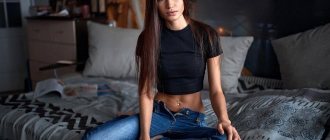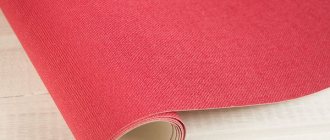Summer requires appropriate clothing and suitable fabric. Lightweight, comfortable materials will protect against overheating and skin irritation, and will not hinder movement. Preference is given to hygroscopic and antibacterial fabrics that absorb moisture, dry quickly and allow air to pass through the fibers well. Due to the summer heat, clothes often need to be washed, so you need to choose easy-to-care materials that retain their attractive appearance after numerous washes.
Natural raw materials for fabric
To create a comfortable summer wardrobe, not only the type of fabric is important, but also its composition. Natural fibers are considered the most suitable option for hot weather because they almost always absorb moisture well and “breathe”.
- Hemp is almost as ancient a raw material for clothing as silk. In Russia, hemp began to be grown during the reign of Peter the Great, and the resulting material was called hemp. In modern times, a variety of hemp that does not contain narcotic drugs is cultivated to make fabric. Hemp fabrics are very durable, wear-resistant and hypoallergenic. They absorb moisture well, do not accumulate static electricity, and also hardly wrinkle. Hemp is soft and light to the touch and retains color well.
- Linen fabrics were made back in the Neolithic era, also in Ancient Egypt. In modern times, flax is harvested by a combine, the straw is soaked, dried, washed and woven, and then spun into yarn. The fabric is environmentally friendly and conducts heat well. Linen is durable, does not electrify, is breathable and contains silica, which does not allow the development of bacteria and microorganisms.
- Ramie is a plant fiber obtained from Chinese nettle. Even with prolonged contact with water, this fabric does not rot. The material is soft, comfortable, breathable. Summer pants and shorts are made from ramie, and fibers are added to other fabrics.
- Cotton is harvested from the fields using special combines, and there are also small family businesses where the soft fibers are still harvested by hand. Cotton fabrics fit very nicely to the body, “breathe”, absorb moisture, but at the same time they are not at all elastic, wrinkle, dry slowly and do not last long. However, cotton is considered a universal material for hot weather.
- Silk is a protein fiber obtained from the cocoons of silkworms. The technology for making silk thread and fabric was invented in China more than five thousand years ago. Natural silk is a hygroscopic, durable and shape-stable material with a soft shine.
- Wool is obtained from the hair of furry animals (goats, sheep, llamas, camels), which are shorn, and yarn is made from the resulting raw materials. Wool is a very warm and hygroscopic material; only the finest fibers are used for sewing summer fabrics. Wool threads are used, for example, to create lightweight georgette fabric.
Types of summer clothes made from natural fabrics:
- dresses, sundresses, tunics;
- blouses and shirts;
- overalls;
- home clothes (robes, shirts);
- T-shirts, tank tops, tops;
- trousers and shorts;
- headwear (caps, Panama hats);
- shoes (moccasins, sneakers, elements of flip-flops and sandals);
- lightweight beach bags.
Synthetic threads can be found in many modern fabrics. Don’t be scared right away and give up the thing you like. It is synthetic fibers that reduce the cost of the product and also improve its characteristics. For example, cotton fabric with a small addition of synthetics will not wrinkle, and elastic lycra will allow the item to fit perfectly. However, people with sensitive skin and allergy sufferers should avoid synthetic materials.
Linen
In hot weather, it is best to wear a dress made of natural, lightweight, breathable fabric, such as linen. Moreover, linen fabrics are back in trend. Fashion designers again paid attention to clothes made from this material.
Linen is the most environmentally friendly raw material for the production of natural fabric, which even surpasses cotton in properties. Its cultivation does not require pesticides and does not require as much water as cotton fields.
In hot weather, linen fabric with a rough surface is especially pleasant. It is breathable, comfortable for the body, does not cause irritation or allergies, has antibacterial properties, and is hygroscopic. In addition, linen fabric is durable, hardly stretches, and requires little maintenance.
Its drawback, and it is perhaps the only one, is that it wrinkles a lot. But even this feature of linen fabric can be used. Designers don't see this as a negative. On the contrary, they turn this drawback into some kind of feature of this material.
The absolute hit of summer is a linen sundress. Due to the rigidity of the structure of natural linen, straight or A-line models are sewn from it. On vacation by the sea, in the country, in the city on a hot day, short or long, flared or straight, narrow or wide - a woman of any size and age can choose something to suit her taste.
Linen clothing is varied not only in style and style, but also in color. Some people will like the natural colors of natural fabric, while others will choose richly colored bright outfits. Embroidery, beads, lace, applique, and decorative elements from Russian costume are appropriate in combination with this fabric.
A simple linen sundress, complemented with accessories, jewelry, a belt, a hat, shoes, and a handbag, can become the basis for creating your own style, providing freedom of movement and convenience. Which is especially important in hot weather.
Sports sandals with woven leather straps, bracelets, earrings made of beads, amber, semi-precious stones, and wooden beads in an ethnic style will go well with a summer sundress.
Batiste
The fabric can be plain, patterned, or bleached.
Translucent, delicate and thin material made of cotton or linen. The weave of the threads is plain. The canvas can be smooth, as well as with patterns and ornaments. To make cambric, thin twisted yarn is used. The fabric can be plain, patterned, bleached and mercerized (special treatment to prevent fading). The most expensive and high-quality cambric is made from the finest hand-spun linen threads.
Fabric characteristics:
- environmental friendliness;
- hypoallergenic;
- ease;
- dimensional stability;
- ease of care;
- the fabric does not fade;
- does not wrinkle.
Nightgowns, blouses and dresses, as well as accessories (gloves and belts) are made from cambric. To maintain the aesthetic appearance of the product for as long as possible, it must be properly cared for. Both hand and machine washable in delicate mode. Wring out the products by hand and dry in the shade. If necessary, cambric is ironed through gauze.
General fashion trends
If you do not focus on one type of fabric or another, designers, inspired by the historical past, suggest focusing on vintage in summer outfits, using individual decorative elements and cuts from clothes of past centuries. For example, fluffy skirts, voluminous sleeves, a lot of lace, corsets, embroidery.
The loose silhouette is still not going to give way to the catwalk. Although the classics are still alive - straight cut, fitted and A-line.
The leaders are shirt dresses of various styles and lengths with minimalist decor. And also Baby-doll models of loose fit, mini, maxi or medium length, with flounces, frills, puff sleeves and a high waistline. By the way, this style helps to neatly hide the tummy.
One of the trends of past centuries is dresses with puff sleeves. This detail has appeared more than once in women's clothing over many years of history. And now again it is chosen by women who want to emphasize the romance and femininity of the image.
Stylish sundresses of various models still dominate the catwalk: a classic cut and flared dress with thin straps, knee-length for work, a light long model for relaxing at sea, a plain sundress with accessories for a cocktail outfit.
Viscose
A very interesting fabric that is made from... trees. More precisely, from wood cellulose, which is crushed, split and treated with a special solution. Then strong threads are formed. Viscose is not a synthetic or natural fabric, it is artificial, that is, simply processed from natural materials.
Positive properties of viscose:
- drapeability;
- aesthetic soft shine of the surface;
- hygroscopicity;
- the fabric allows air to pass through well;
- not electrified.
Viscose becomes brittle when wet, so it is often reinforced with additional fibers. T-shirts, skirts, dresses and sundresses are made from this fabric. Things made of viscose are washed by hand or in a machine, using a delicate cycle. You should also choose mild detergents. Viscose is ironed through a soft fabric.
Synthetic fibers
Such fabrics are created by the synthesis of simple substances obtained from natural and petroleum gases, oil and coal tar. Types of synthetic fibers:
- polyester
- polyamide
- polyvinyl chloride
- polyacrylonitrile
Polyamide includes nylon and anide, which are widely used today in the production of clothing for men and women. They sew from them:
- dresses
- blouses for women
- decorative furs
- socks
- raincoats for men and women, stockings and tights
Polyamide fabrics are characterized by high strength and the ability to stretch and contract, which is called elasticity. If you add 15% nylon to viscose, then this item of clothing will “wear off” 2-4 times slower. Clothing made from polyamide fibers weighs less when compared to clothing made from artificial fabrics.
Kapron is characterized by the following indicators:
- high heat conductivity
- low hygroscopicity
- low resistance to sunlight
- low temperature resistance
Therefore, nylon is not very useful for adults, and even more so for children. Wearing nylon affects the activity of the sebaceous and sweat glands, so irritation may appear on the skin. Due to high thermal conductivity, body hypothermia can occur. If you wear nylon products in winter, your feet may get frostbite. If you have skin diseases, it is better to avoid wearing nylon.
Polyester fibers are primarily laxan. In Canada and Britain it is known as terylene, and in the States it is called dacron. Externally, this material resembles fine wool. Its heat-protective properties are almost the same as those of wool, but its strength is 3 times higher. Also, polyester fiber lavsan is characterized by the following properties:
- crease resistance
- elasticity
- chemical stability
- thermal stability
- sun resistance
- abrasion resistance
- resistance to chemicals and even bacteria
- low hygroscopicity
- low water capacity
- low electrification
- high air and vapor permeability
Since the hygroscopicity of this fabric is very low, underwear cannot be made from it. But it can be added to fabric for sewing suits and dresses.
Nitron is known among polyacrylonitrile fibers in our country. In Germany it is called prelan. Like the material described above, it resembles wool fiber in appearance. Nitron is characterized by the following properties:
- resistance to bacteria
- softness
- looseness
- elasticity
- low creasing, etc.
Nitron is relevant for sewing suits, knitwear, faux fur and even bed linen. Polyacrylonitrile also has a number of disadvantages. It has low hygroscopicity, high hydrophobicity, and relatively low strength.
Polyvinyl chloride fibers are used for the production of clothing and footwear. Widespread of this group are PVC fiber and chlorine. Chlorine fiber normally tolerates high temperatures, exposure to light, and contact with chemicals. One of the disadvantages is low strength. These fibers are used to create fabrics for sewing coats and dresses, and are also added to knitwear.
When PVC fibers rub against the skin and each other, it causes a build-up of static electricity. This has a negative effect on the body. Clothing made from this material is often treated with antistatic agents.
Guipure
Airy lace fabric with ornamental inserts that connect the patterns. Guipure was invented in Italy; in the 16th century it was ordered from Venetian craftsmen. The material is quite hard, but looks elegant. Suitable for decorating dresses and blouses; if there is little mesh and the fabric is almost opaque, it can be used independently.
Guipure is made from silk, cotton, linen, viscose threads, Lurex is added for decoration, lycra and polyester are added for elasticity.
Advantages of the material:
- practicality;
- dimensional stability;
- ease;
- aesthetic appearance;
- ease of care.
The more lace there is on the guipure fabric, the thicker and stiffer the fabric will be. The material should be protected from tightening and tearing. Despite the external fragility of the fabric, guipure can be washed both by hand and in a machine. Suitable water temperature is 30 degrees, iron temperature when ironing is 150 degrees.
Georgette
The fabric retains its shape well and emphasizes the figure.
Light and delicate, slightly grained fabric made from wool, viscose or silk. Polyester and elastane are also added to the composition. Twisted georgette threads are joined together in a strong plain weave. The texture of the material is quite rigid and retains its shape well, emphasizing the figure.
Fabric Features:
- hygiene;
- hygroscopicity;
- ease;
- wrinkles a little.
Draped dresses, blouses and skirts are made from georgette. The material is also used as finishing. It is recommended to wash georgette by hand using liquid detergent. Before drying, the product is carefully straightened. Iron georgette only from the inside out, preferably through a damp cloth.
Sewing and lace
A great option for summer weather are outfits made from trendy lace and embroidery. These fabrics are light and breathable, and also very beautiful.
Lace and sewing are a fancy, openwork interweaving of threads that form various patterns among themselves. This is very useful for the summer heat, because outfits made of lace and embroidery allow fashionistas to feel comfortable and cool. Lace and sewing can be varied in texture and pattern.
If earlier such beauty was used exclusively for decorative finishing of clothes, and then only for rich people, now fashion and heat dictate that the entire outfit be made entirely of lace.
Satin
Smooth fabric with a silky surface. The weave of the threads is satin. Natural silk and cotton are used to make the material. Due to its elegant appearance, satin is often confused with satin, but the weave of these fabrics is different. There is a variety called jacquard satin - a double-sided material with a large woven pattern.
Fabric Features:
- hygroscopicity and breathability;
- smoothness;
- does not wrinkle;
- pleasant and cool to the touch.
Dresses and blouses are made from satin, and shoes are also covered with this material. To protect the front side of the fabric from puffs, the products are turned inside out. Permissible water temperature is 40-60 degrees. Satin practically does not wrinkle and does not require ironing.
How to keep yourself feeling cool
Summarize. To stay cool and avoid overheating in hot weather, you should wear clothes made from breathable and moisture-wicking fabrics.
If you rely only on breathability, then you need clothes made of fabric with a looser weave of threads. Such fabric is easy to recognize - bring it to a light source. The brighter the light is visible through it, the cooler it will be. In addition, clothes made from such fabric should be loose (but not hang like a bag). These items are best worn in relatively dry climates where sweat can evaporate easily, allowing the body to naturally cool down.
In high humidity environments, as well as for active sports, fabrics that absorb moisture well and dry quickly are suitable.
In addition, modern fabrics combine comfort, antibacterial properties and even protect against ultraviolet radiation.
Therefore, you should select clothes based on your own needs, area of activity and recreation, as well as climatic conditions. And then during the summer you will feel great.
Chintz
Men's and women's summer clothing is made from chintz.
Lightweight plain weave cotton fabric made only from natural fibers. It can be plain or with a pattern. The variegated, brightly colored fabric was invented centuries ago in India. Typically, chintz is made from calico, an untreated plain weave cotton.
Fabric characteristics:
- environmental friendliness;
- color fastness;
- ease of care and safety;
- breathability;
- hygroscopicity;
- affordable price.
Men's and women's summer clothes (dresses, blouses, shirts), as well as household items (robes and shirts) are made from chintz. Due to its 100% natural composition, chintz is not wear-resistant. When purchasing, you need to pay attention to the quality so that the paint does not fade in the future. Chintz also wrinkles a lot.
Before first use, it is recommended to wash the fabric in cold water - this softens the material and protects the paint. The permissible washing temperature is 50 degrees, items must be turned inside out first. To facilitate the ironing process, the fabric is sprayed with water.
Selection rules
When choosing fabric for a dress, you should take into account not only the appearance, color and print of the material, but also its properties and purpose. Experienced designers know the rules for choosing materials that will allow the owner of the dress to feel comfortable. The materials for summer dresses and those intended for winter vary. The choice of material depends on the structure and print of the material. The materials used to sew dresses for curvy girls may not be suitable for slender women, while the use of some fabrics is appropriate only for tall and thin girls. The rules described below will tell you how to choose fabric for a dress.
Rules that you should pay attention to when choosing a piece of fabric for a dress:
- The purpose of the finished outfit is determined. Knowing which fabric to choose for sewing home clothes and which for evening wear, it is easier to determine the structure of the material for a specific purpose;
- It is necessary to determine how matter holds its shape. Some outfits require thick materials to sew. Modern varieties of fabrics provide the opportunity to choose a material with the required density. To sew a summer outfit with a train, you need to take flowing fabric, and for strict winter outfits, jacquard fabrics are suitable;
- It is determined what the cost of fabric for the dress will be. Sewing voluminous maxi-length dresses will require many meters of material. In this regard, the price of the finished outfit will increase. Having calculated in advance how much material you will need, you can choose a material whose price category will fit into your budget;
- The style is determined. For transformer models, wrinkle-resistant material is needed, for outfits with a knitted collar - thick, and for dresses for the summer - thin or translucent.
You should calculate how much fabric you need for a dress before purchasing a cut in the store. By calculating in advance how much fabric you need, you can avoid problems during sewing when there is not enough material. Fabric calculations are made depending on the physical parameters of the body (girth and height) and the style of the finished outfit. The length of the skirt is taken into account. Sewing a knee-length skirt requires significantly less material than sewing a maxi skirt.
When sewing, the studio often calculates the amount of fabric needed and informs the client. Tailors determine the quantity depending on the volume of the chest and hips, the presence of sleeves, as well as the style (cut or one-piece). When providing such services, you should adhere to the quantity of material specified by the seamstresses when purchasing, since experienced specialists know better how to calculate the fabric consumption.
Tulle
Lightweight mesh fabric of French origin. Made from cotton with the addition of polyester and silk. The canvas is decorated with a pattern, which is made on special tulle machines. The material is painted and decorated with lurex and rhinestones.
Fabric Features:
- ease;
- transparency;
- breathability;
- aesthetic beauty.
Tulle is used to decorate women's dresses, blouses and skirts; most often the fabric is used as a decoration for smooth and opaque materials. Caring for the products is very simple. The tulle is soaked in soapy water and then washed by hand. The fabric dries very quickly and does not need to be ironed. Tulle is protected from exposure to high temperatures so that the product does not deform.
Fatin
Most often, fluffy, wrinkle-resistant skirts are made from mesh.
Lightweight and stiff mesh fabric, most often made from synthetic nylon, polyester, elastane, and also viscose. Belongs to a special group of fabrics called mesh. The main feature of the material is the large gap between the weft and warp threads, forming a cell.
In appearance, tulle can be shiny or matte; the fabric is decorated with rhinestones, metallic sequins, embroidery, various coatings, and is also dyed in various colors.
Positive properties of tulle:
- elasticity and dimensional stability;
- wear resistance and strength;
- does not absorb moisture and dirt;
- dries quickly;
- allows air to pass through well.
Tulle is rarely used on its own because it is very harsh and can irritate the skin. Most often, petticoats and fluffy, wrinkle-resistant skirts are made from mesh. The tulle is washed by hand so that the drum of the washing machine does not damage the structure of the fabric, then rinsed well. The material does not wrinkle, but if persistent creases have formed, the tulle is treated with steam.
Flowing dense
Barbie
Barbie is a costume material for business wear. Characterized by softness and elasticity due to stretch fibers. The texture of the fabric is rough, dense and soft to the touch. The matte material is pleasant and comfortable to wear. It has a synthetic composition of polyester, viscose and spandex with the addition of elastane. Barbie fabric can be plain or patterned.
Crepe suit
A popular fabric for everyday and formal wear, as well as sheath dresses. It has a presentable appearance and positive performance characteristics. The fabric is dense, with the inherent crepe grain. Minimal give ensures good fit and comfortable wear. The fabric does not stretch and does not interfere with freedom of movement. Mostly a plain crepe suit is produced. Patterns and prints are less common. The composition includes natural and synthetic fibers: cotton, wool, polyester, acrylic and viscose.
Stretch velor
Stretch velor is a luxurious material. The material has a soft, fleecy surface with a sparkling shine. The dense structure of the fabric acquires elasticity due to stretch fibers. The material is pleasant to the touch and comfortable to wear. Gracefully fits the figure. It is presented on the market in a plain-painted version in a palette of shades. Suitable for evening and ball gowns, skirts and knee socks.
Gabardine
Gabardine is a dense, light and soft fabric that is resistant to deformation. Lacks elasticity except for the stretch version. It turns out to be a twill weave, which leaves a diagonal scar on the matte surface. The material is double-sided.
Available in wool gabardine, blended, cotton, silk, stretch and synthetic. Pleasant to wear and practical, the material is made in plain colors, checkered, or printed.
Chambray
Chambray, or chambry, is one of the types of denim fabrics. The material was invented in France in the 16th century. This is a soft, lightweight fabric, reminiscent of cambric in its structure. Chambray is made from cotton using a twill weave. The finished fabric has a fine diagonal ribbed pattern.
Advantages of chambray:
- lightness and density;
- wear resistance;
- hygroscopicity;
- breathability;
- not electrified;
- does not allow dust to pass through.
Due to its natural composition, chambray wears and fades over time, dries slowly and shrinks after washing. Comfortable summer trousers, shorts, dresses and shirts are made from chambray. The fabric withstands both machine and hand washing and practically does not wrinkle. The permissible water temperature when washing is 40 degrees.
